|
CHINA SCIENCE AND TECHNOLOGY
NEWSLETTER
The Ministry of Science and Technology
People's Republic of China
|
|
|
N0.559 |
September 20, 2009 |
|
|
|
|
|
|
|
|
IN THIS ISSUE
|
|
*Greatly Enhanced S&T Input
*Huge Potentials for China-Russia S&T Cooperation
* Novel Artificial Hand
*China Builds New Launching Site
*First Home Made Spot Welding Robot
*Submarine Cable Security System
|
Greatly Enhanced S&T Input
LI Xueyong, Chinese Vice-Minister of Science and Technology, briefed the media of China’s S&T development in the last six decades at a news conference held on September 17, 2009 by the State Council Information Office. LI said at the beginning of the founding of the People’s Republic of China, China had very limited government appropriations for S&T activities. For example, China had only RMB 56 million worth S&T budget for 1953. In 2008, government S&T appropriations reached RMB 240 billion, a more than 40 times growth, compared with 1978 where reform and opening up began. In the past 60 years, China has achieved laudable S&T accomplishments mainly as follows: the establishment of a well functioned modern S&T system and a capable S&T personnel contingent, a greatly raised scientific research level, technology breakthroughs in key engineering areas, rigorous development of high tech industry, remarkable social benefits derived from S&T development, full-fledged construction of a national innovation system, and enhanced international S&T cooperation. In 2009, the state treasury has made RMB 146.1 billion available for S&T activities, or 25.6% up compared with 2008. Thanks to the guidance and support of government appropriations and relevant policies, Chinese industry has become a major player in S&T oriented investment, with 70% as a proportion of the total S&T expenditures in the country. In 2008, China had an R&D expenditure that was 1.52% (RMB 457 billion) as a proportion of GDP.
Traditional Regimen Center Established
China Academy of Chinese Medical Sciences launched on September 15, 2009 a project to study traditional regimens in Beijing. According to a briefing, the project is initiated to carry on traditional regimen culture, improve people’s health, study traditional regimen theories/techniques, develop innovative techniques, and stage relevant training activities. It will be built into a 3-D service network diffusing traditional regimen knowledge and techniques, and an open R&D platform combining the strength of research institutes, hospitals, and manufacturers, and operating upon the market needs, in three years. Based in Beijing, the new center will become a traditional regimen leader in terms of quality, scale, and earnings. With the support of the Ministry of Health, Ministry of Science and Technology, State Administration of Chinese Traditional Medicine, and State Food and Drug Administration, the new center will formulate criteria for the sound development of traditional regimen industry, and demonstrate the strength of traditional regimen in curing the illness that has not yet become a disease.
|
INTERNATIONAL COOPERATION |
Huge Potentials for China-Russia S&T Cooperation
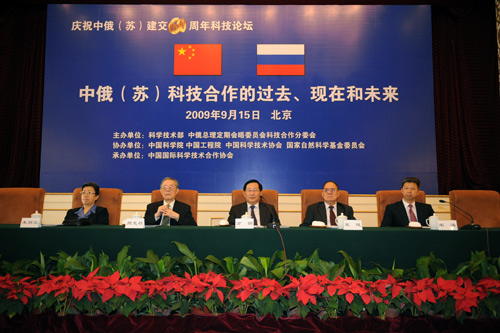
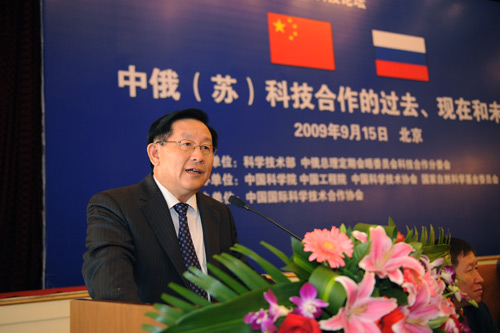

A ceremonial forum was held on September 15, 2009 in Beijing to honor the 60th anniversary of the establishment of diplomatic relations between China and Russia (the former Soviet Union), and the 55th anniversary of signing of China-Soviet Union S&T Cooperation Accord. Senior officials of Chinese Ministry of Science and Technology, Ministry of Foreign Affairs, Chinese Academy of Sciences, Chinese Academy of Engineering, China Association for Science and Technology, and National Natural Science Foundation, and scientists/engineers attended the event.
WAN Gang, Chinese Minister of Science and Technology, recalled the unusual friendship and S&T cooperation fostered between the two peoples and two countries in the past six decades. He said in his speech that the former Soviet Union helped the People’s Republic of China to build its S&T capability from scratch through 156 projects, and assisted the latter to formulate and implement its first long term S&T development plan. It also offered generous assistance to China in the area of technology, equipment, materials, and training.
WAN added that S&T cooperation between the two countries has enjoyed laudable progresses and accomplishments in the last few years. S&T cooperation has operated in a multi-level, multi-channel, and overall manner, and has become an area where two countries can supplement one another for more potentials. He hopes that more efforts shall be made to encourage and attract young scientists and engineers to be part of S&T cooperation on the basis of equality and mutual benefit, allowing the cooperation to go faster and better, and rendering its contribution to the wellbeing of two peoples.
New Fossilized Dinosaur Found
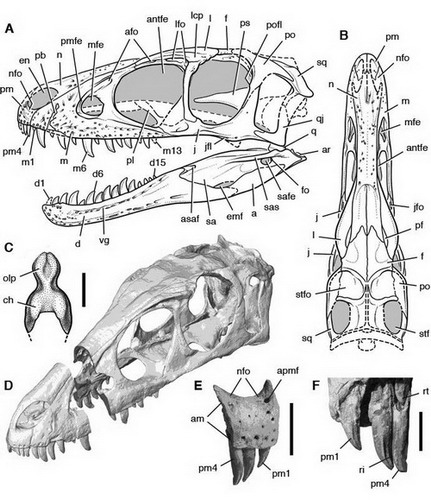
Anatomic features of a 9-feet dinosaur living in the northeast part of China 125 million years ago
ZHAO Xijin, a research fellow at Institute of Vertebrate Paleontology and Paleoanthropology, part of the Chinese Academy of Sciences, and Paul Sereno, a paleontologist at the University of Chicago, published their findings on a newly discovered dinosaur that livedapproximately 125 million years ago. They believe that the 9-feet long dinosaur found in the northeast part of China has already possessed the anatomic features that a tyrannosaur had. In the September 17 online issue of Science, paleontologists named the new dinosaurs Raptorex, and displayed all the features that it had passed to its descendent: tyrannosaur, including large skull, small limbs, and thin but long palms built for running. The Raptorex skull also displayed enlarged olfactory bulbs, as in tyrannosaur, implying a highly developed sense of smell.
Mechanism Regulating S2P Activity Unveiled
Regulated intramembrane proteolysis (RIP) by the Site-2 protease (S2P) results in the release of a transmembrane signaling protein. However, S2P cleavage must be preceded by the action of the Site-1 protease (S1P). A team, led by Prof. SHI Yigong at Tsinghua University Department of Biological Sciences and Biotechnology, deciphered the underlying mechanism through biochemical and biological means. Researchers found that the newly exposed carboxyl-terminal residue amino acids play an essential role in regulating the activity of S2P. The finding was published in the September 1st issue of the Proceedings of the National Academy of Sciences.
New Progress for Multifunctional Molecule Components
A group of researchers at the University of Science and Technology of China skillfully performed an operation on a single melamine molecule that is less than 1/60,000 of a hair in size, using a scanning tunneling microscope, and turned melamine, a raw chemical, into a dual-functional (rectifying and switching) single molecule component. The finding, published in the recent issue of the Proceedings of the National Academy of Sciences, explains a new technical line for developing multifunctional single molecule components.
Researchers found through 3-year study that melamine molecules can be manipulated and turned into a dual-functional component for both rectifying and switching operation. Under indoor temperature, melamine molecules would go through a chemical reaction by shedding two hydrogen atoms, when adsorbed on a Cu surface, and become firmly bonded onto the Cu surface and acts as a normal conductor controlled by elastic electron tunneling. A current-induced hydrogen tautomerization process results in an asymmetric melamine tautomer, which in turn leads to a significant rectifying effect. Furthermore, by switching on inelastic multielectron scattering processes, mechanical oscillations of an N-H bond between two configurations of the asymmetric tautomer can be triggered with tunable frequency. Collectively, the designed molecule exhibits rectifying and switching functions simultaneously over a wide range of external voltage. The study was funded by the Chinese Ministry of Science and Technology, National Natural Science Foundation, and the Chinese Academy of Sciences.
Novel Artificial Hand
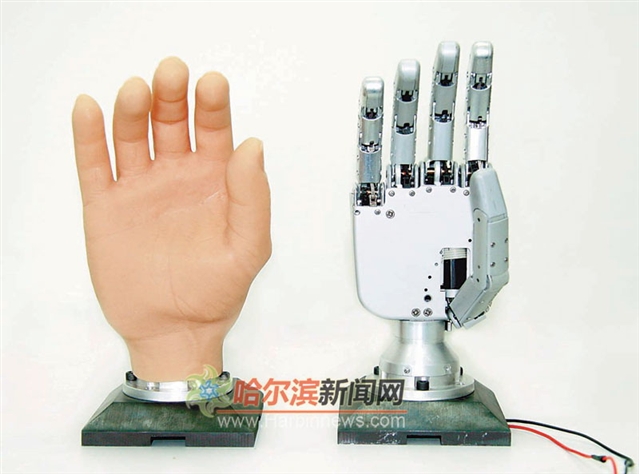
New generation artificial hand.
A project to develop the new generation of artificial hand has recently passed an approval check. The novel artificial hand, with five fingers that can move independently, works like a real human hand, having the feeling of both strength and location, and allowing the disabled to work on keyboards.
Weighing 500g and having the size of an adult hand, the five-finger artificial hand is driven by three motors, with the thumb and forefinger being driven by their own motors, and others by one motor. The newly designed thumb is able to move along the trajectory that a real thumb would move, with other fingers being able to adapt to the shape of the object they grasp. According to Prof. LIU Hong, the developer, the highly integrated artificial hand can easily perform the action of grasping, gripping, squeezing, and knocking, and is a desirable helper for the disabled.
China Builds New Launching Site

Command and flight control center.

Launching pad.
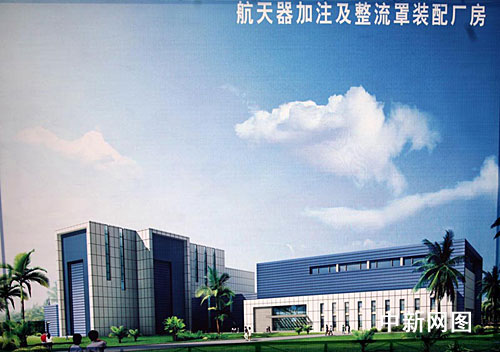
Fueling and assembling.

Launching vehicles.
On September 14, 2009, China broke ground for constructing a new space vehicle launching site in Hainan Province. The new launching site is made up of a launching pad, and control station. Sitting in a geographic location of 19 degrees north latitude, the new launching site will be put into operation in 2013 to launch new generation toxicants and pollution free launch vehicles, geosynchronous satellites, large polar orbiting satellites, space stations, and deep space probes. The new launching site is designed to serve both domestic and international needs for space vehicle launch, and will be a stimulus to the sound development of China’s space industry.
First Home Made Spot Welding Robot
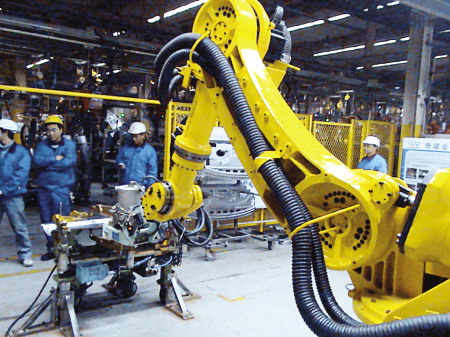
A QH-165 spot welding robot, jointly developed by Harbin Engineering University and Chery Auto, passed an approval check on September 7, 2009. Invested by Chery Auto and developed by Harbin Engineering University, the spot welding robot operates in an interactive manner, and has welded several tens of thousands of car components in nearly one-year trial operation.
Submarine Cable Security System
Not long ago, Ningbo based NUOKE Tech rolled out the first submarine cable warning and positioning system in the country, thanks to the support of Ministry of Science and Technology. The new system is able to keep an eye on the safe operation of submarine cables, by detecting abnormal changes of the ambient environment and telling the detailed sites where the cable has been damaged (50m for margin of error). Designed to monitor submarine cable operations as far as 50 km, the system makes accurate warning and positioning, desirable for monitoring external invasions.
Safe Leakage Tires
An effort to develop the key technologies for manufacturing safe auto tires has achieved major progresses. Initiated under the National S&T Support Program for the 11th Five-year period (2006-2010), the project has resulted in China’s first safety tire production line in Conghua City, Guangdong Province. The production line produces two types of high performance Meridian tires (195//55RF16 and 205/45RF17) with their technical indicators up to the design targets. The tire, when leaked, is able to get to the destination safely at a speed of 80km an hour. The new tire has passed ECE-R30 accreditation, with a zero-pressure reading that is noticeably better than the ECE standard. The tire manufacturer has been granted with the first order for 1000 tires.
Quick Prenatal Diagnosis
A three-year study to apply the fluorescence in situ hybridization (FISH) technique in detecting inherited diseases at the prenatal stage has recently passed an approval check organized by the Chinese Ministry of Health. Comparing with traditional approaches that produce the result in 10-14 days, the new technique enjoy numerous merits, including simpler, faster, and more accurate diagnosis, and able to produce the result in 24-48 hours. Up to date, 55 prenatal diagnosis centers equipped with the FISH operating and analysis platform have started to provide clinical services. The home made probe derived from the efforts has been approved for mass production.
Comments or inquiries on editorial matters or Newsletter content should be directed to:
Department of International Cooperation, MOST 15B, Fuxing Road, Beijing 100862, PR China Tel: (8610)58881360 Fax: (8610) 58881364
http://www.most.gov.cn |

